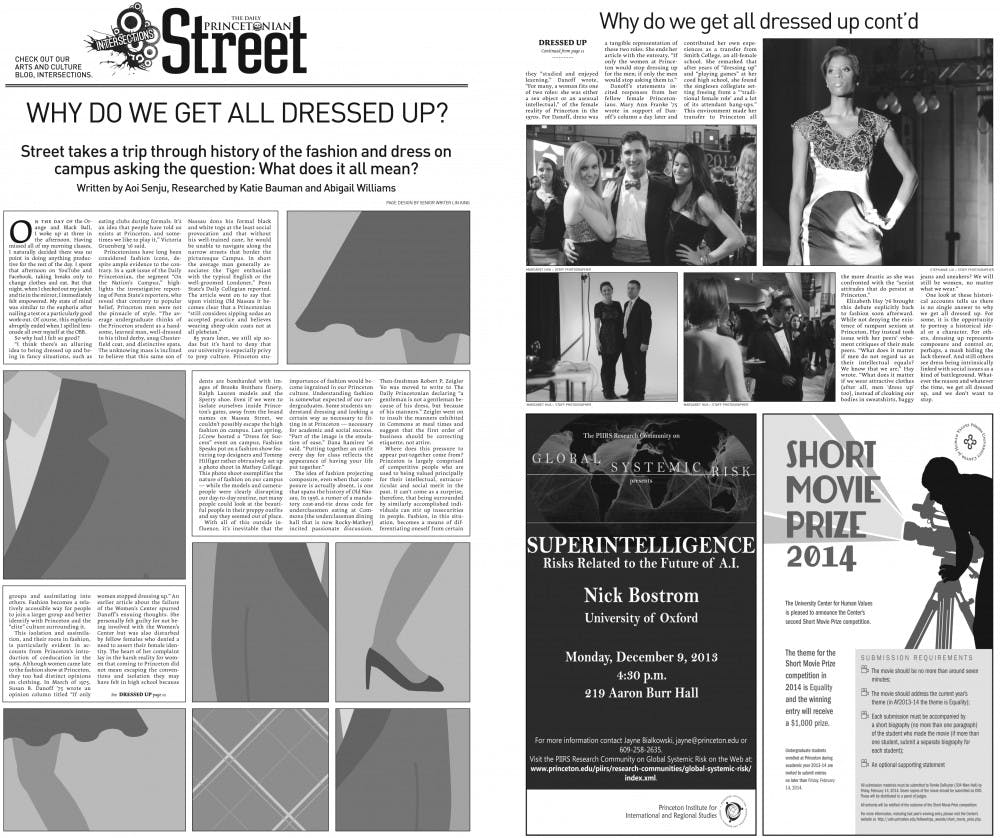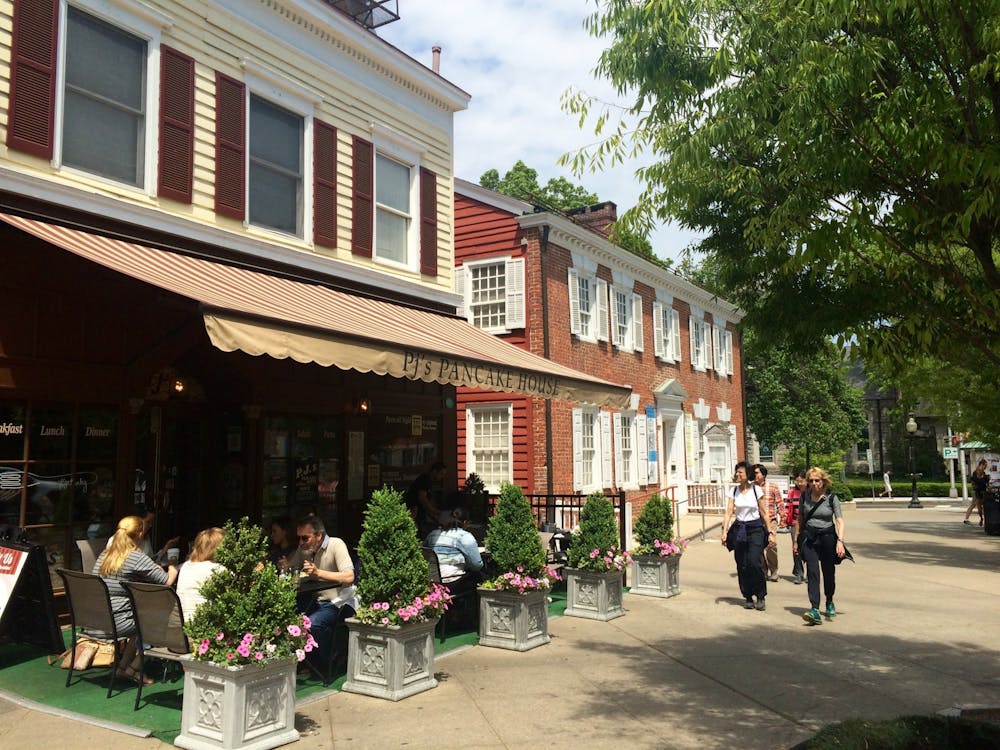On the day of the Orange and Black Ball, I woke up at three in the afternoon. Having missed all of my morning classes, I naturally decided there was no point in doing anything productive for the rest of the day. I spent that afternoon on YouTube and Facebook, taking breaks only to change clothes and eat. But that night, when I checked out my jacket and tie in the mirror, I immediately felt empowered. My state of mind was similar to the euphoria after nailing a test or a particularly good work-out. Of course, this euphoria abruptly ended when I spilled lemonade all over myself at the OBB.
So why had I felt so good?
“I think there’s an alluring idea to being dressed up and being in fancy situations, such as eating clubs during formals. It’s an idea that people have told us exists at Princeton, and sometimes we like to play it,” Victoria Gruenberg ’16 said.
Princetonians have long been considered fashion icons, despite ample evidence to the contrary. In a 1928 issue of the Daily Princetonian, the segment “On the Nation’s Campus,” highlights the investigative reporting of Penn State’s reporters, who reveal that contrary to popular belief, Princeton men were not the pinnacle of style. “The average undergraduate thinks of the Princeton student as a handsome, learned man, well-dressed in his tilted derby, snug Chesterfield coat, and distinctive spats. The unknowing mass is inclined to believe that this same son of Nassau dons his formal black and white togs at the least social provocation and that without his well-trained cane, he would be unable to navigate along the narrow streets that border the picturesque Campus. In short the average man generally associates the Tiger enthusiast with the typical English or the well-groomed Londoner,” Penn State's Daily Collegian reported. The article went on to say that upon visiting Old Nassau it becomes clear that a Princetonian “still considers sipping sodas an accepted practice and believes wearing sheep-skin coats not at all plebeian.”
85 years later, we still sip sodas but it’s hard to deny that our university is especially privy to prep culture. Princeton students are bombarded with images of Brooks Brothers finery, Ralph Lauren models and the Sperry shoe. Even if we were to isolate ourselves inside Princeton’s gates, away from the brand names on Nassau Street, we couldn’t possibly escape the high fashion on campus. Last spring, J.Crew hosted a “Dress for Success” event on campus, Fashion Speaks put on a fashion show featuring top designers and Tommy Hilfiger rather obtrusively set up a photo shoot in Mathey College. This photo shoot exemplifies the nature of fashion on our campus — while the models and camera-people were clearly disrupting our day-to-day routine, not many people could look at the beautiful people in their preppy outfits and say they seemed out of place.
With all of this outside influence, it’s inevitable that the importance of fashion would become ingrained in our Princeton culture. Understanding fashion is somewhat expected of our undergraduates. Some students understand dressing and looking a certain way as necessary to fitting in at Princeton — necessary for academic and social success. "Part of the image is the emulation of ease,” Dana Ramirez ’16 said. “Putting together an outfit every day for class reflects the appearance of having your life put together.”
The idea of fashion projecting composure, even when that composure is actually absent, is one that spans the history of Old Nassau. In 1956, a rumor of a mandatory coat-and-tie dress code for underclassmen eating at Commons (the underclassman dining hall that is now Rocky-Mathey) incited passionate discussion. Then-freshman Robert P. Zeigler ’60was moved to write to The Daily Princetonian declaring “a gentleman is not a gentleman because of his dress, but because of his manners.” Zeigler went on to insult the manners exhibited in Commons at meal times and suggest that the first order of business should be correcting etiquette, not attire.
Where does this pressure to appear put-together come from? Princeton is largely comprised of competitive people who are used to being valued principally for their intellectual, extracurricular and social merit in the past. It can’t come as a surprise, therefore, that being surrounded by similarly accomplished individuals can stir up insecurities in people. Fashion, in this situation, becomes a means of differentiating oneself from certain groups and assimilating into others. Fashion becomes a relatively accessible way for people to join a larger group and better identify with Princeton and the “elite” culture surrounding it.
This isolation and assimilation, and their roots in fashion, is particularly evident in accounts from Princeton's introduction of coeducation in the 1969. Although women came late to the fashion show at Princeton, they too had distinct opinions on clothing. In March of 1975, Susan B. Danoff ’75 wrote an opinion column titled “If only women stopped dressing up.” An earlier article about the failure of the Women’s Center spurred Danoff’s ensuing thoughts. She personally felt guilty for not being involved with the Women’s Center but was also disturbed by fellow females who denied a need to assert their female identity. The heart of her complaint lay in the harsh reality for women that coming to Princeton did not mean escaping the conventions and isolation they may have felt in high school because they “studied and enjoyed learning.” Danoff wrote, “For many, a woman fits one of two roles: she was either a sex object or an asexual intellectual,” of the female reality of Princeton in the 1970s. For Danoff, dress was a tangible representation of these two roles. She ends her article with the entreaty, “If only the women at Princeton would stop dressing up for the men; if only the men would stop asking them to.”
Danoff’s statements incited responses from her fellow female Princetonians. Mary Ann Franke ’75 wrote in support of Danoff’s column a day later and contributed her own experiences as a transfer from Smith College, an all-female school. She remarked that after years of “dressing up” and “playing games” at her coed high school, she found the singlesex collegiate setting freeing from a “'traditional female role’ and a lot of its attendant hang-ups.” This environment made her transfer to Princeton all the more drastic as she was confronted with the “sexist attitudes that do persist at Princeton.”
Elizabeth Hay ’76 brought this debate explicitly back to fashion soon afterward. While not denying the existence of rampant sexism at Princeton, Hay instead took issue with her peers' vehement critiques of their male peers. "What does it matter if men do not regard us as their intellectual equals? We know that we are,” Hay wrote. “What does it matter if we wear attractive clothes (after all, men ‘dress up’ too), instead of cloaking our bodies in sweatshirts, baggy jeans and sneakers? We will still be women, no matter what we wear.”
One look at these historical accounts tells us there is no single answer to why we get all dressed up. For some, it is the opportunity to portray a historical ideal or a character. For others, dressing up represents composure and control or, perhaps, a mask hiding the lack thereof. And still others see dress being intrinsically linked with social issues as a kind of battleground. Whatever the reason and whatever the time, we get all dressed up, and we don't want to stop.








